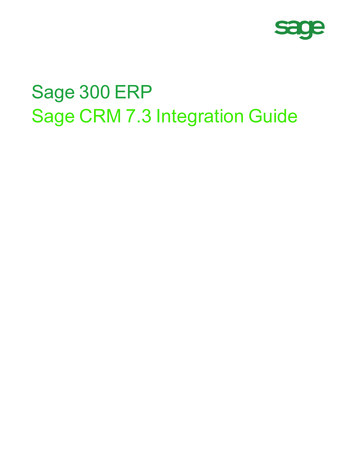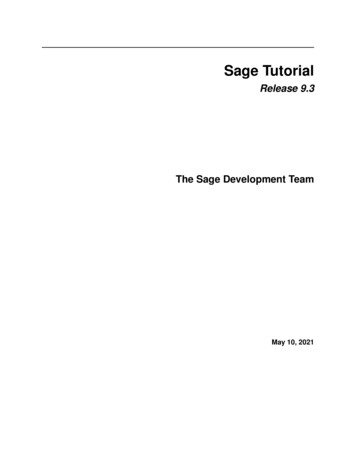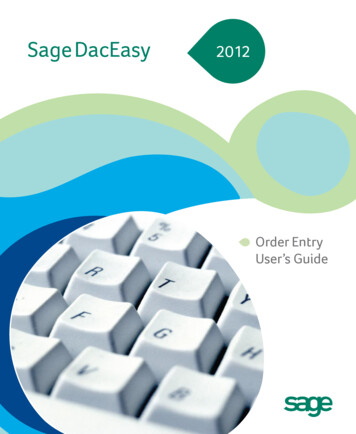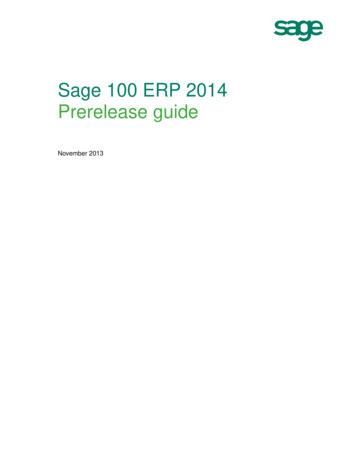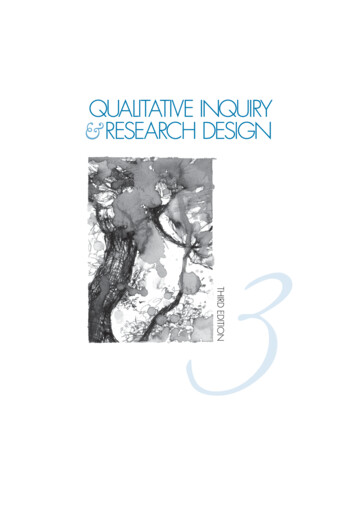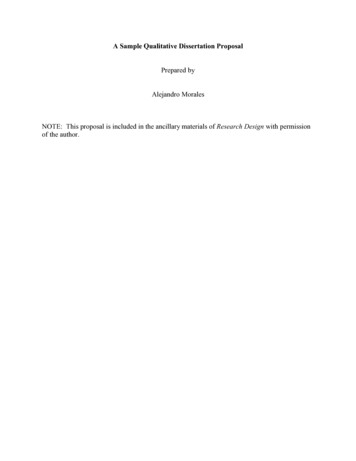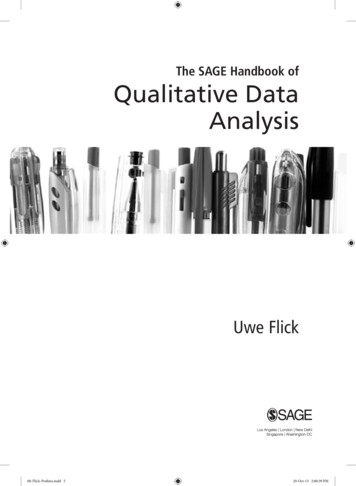
Transcription
The SAGE Handbook ofQualitative DataAnalysisUwe Flick00-Flick-Prelims.indd 529-Oct-13 2:00:39 PM
1Mapping the FieldUwe FlickData analysis is the central step in qualitativeresearch. Whatever the data are, it is theiranalysis that, in a decisive way, forms theoutcomes of the research. Sometimes, datacollection is limited to recording and documenting naturally occurring phenomena, forexample by recording interactions. Thenqualitative research is concentrated on analysing such recordings. Given the centralityof the analysis in qualitative research, ingeneral, a kind of stocktaking of the variousapproaches to qualitative analysis and of thechallenges it faces seems necessary. Anyoneinterested in the current state and development of qualitative data analysis will find afield which is constantly growing and becoming less structured. There are many changeswhich have evolved in parallel, making thefield even more complex than it used to be.This introductory chapter aims to map thefield of qualitative data analysis by discussing its extension and by drawing a number ofaxes through the field that the handbook willcover in its chapters. We will look at the current variety of traditional and new methods01-Flick Ch-01 Part I.indd 3for analysing qualitative data before weconsider the expansion of the phenomenaand data available for analysis. The dimensions demarcating the proliferation of qualitative research and, especially, qualitativedata analysis will be discussed here andunfolded in more detail in the individual chapters. After a definition of qualitative data analysis the major aims of qualitative data analysiswill be outlined – such as reducing big datasets to core elements or expanding smallpieces of data by adding extensive interpretations. Discussing some theoretical backgrounds and basic methodological approacheswill complement this sketch of the field.As the first axis, a historical line will bedrawn, which intersects a second axis concerning geographical diversity, which issometimes ignored. In the next step, we willlook at the role of data analysis in the researchprocess. Another axis is linked to the difference between producing new data and takingexisting, naturally occurring data for a researchproject. A further distinction is related to themajor approaches to analysing data – either29-Oct-13 2:00:43 PM
4MAPPING THE FIELDto reduce the volume or the complexity of thedata, or to expand the existing material bywriting new texts consisting of interpretations about it. The rather simple relation ofone kind of data to be analysed with onemethodological approach has become morecomplex at both ends when triangulation ispart of the methodology of a project. Whatare the consequences for the analysis if multiple types of data are employed? Whatbecomes ‘visible’ if several forms of analysisare applied to the same set of data? Anotheraxis through the field is linked to the tensionbetween formalization and intuition in theanalysis. At the end of this chapter, somenew trends and developments in the field willbe outlined. Here, new types of data, a trendto visualization and developments on thelevel of technological support for doing theanalysis will be discussed. Qualitativeresearch is more and more confronted withsome new challenges – how to make dataavailable for re- and meta-analysis; what dothe calls for relevance and implementationmean in this context; and what are the ethicalissues around qualitative data analysis? Afterbriefly discussing these issues, an overviewof the handbook and its parts and chapterswill complete this introduction.PROLIFERATION OF QUALITATIVERESEARCHOver the past few decades, qualitativeresearch has undergone a proliferation on atleast three levels. First, it has establisheditself in a wide range of disciplines beyondsuch disciplines as sociology, anthropologyand education. We find qualitative researchnow in such varied fields as nursing, medicine, social work, psychology, informationscience, political science, and the like.Even if in many of these disciplines qualitative research is not in the mainstream ofresearch and not at the core of methodstraining or teaching in general, ongoingresearch increasingly includes qualitativestudies.01-Flick Ch-01 Part I.indd 4These developments have led to an interesting gap, which forms a second level ofproliferation: a variety of methods andapproaches for data analysis have beendeveloped and spelled out in the methodology literature mainly in the original disciplines. The range stretches from contentanalysis to conversation analysis, fromgrounded theory to phenomenological analysis, from narrative to film analysis, fromvisual data analysis to electronic data analysis, etc. (see the respective chapters in thisvolume). However, experience with reviewing articles and PhD and other theses fromdifferent disciplines shows how often theanalysis of qualitative data is done in more orless a ‘hands-on’ way in both the original andthe other disciplines. Researchers sometimes‘just do it’ (to use a phrase of Barney Glaser,1998) or they look for certain topics in theirmaterials and construct an account of theirfindings by illustrating these topics with‘interesting’ quotations from interviews, forexample. These quotes are often not reallyanalysed in the article (or PhD dissertation)but treated as illustrations. Another way ofdescribing (and doing) qualitative data analysis is to mix up tools with methods. Articlesin which the method of data analysis isdescribed by only referring to the QualitativeData Analysis (QDA) program (see Gibbs,Chapter 19, this volume) that was applied arestill quite common. All in all, this means thatthere is a gap between methodological developments on one side and research practice onthe other. This gap results from the lack of asystematic and comparative overview andstocktaking of the variety of analytic procedures that are available for doing qualitativedata analysis. This handbook intends tobridge this gap by giving an overview ofmethodological approaches with a strongfocus on research practice in applying themto data and emphasizes the practical application of methods rather than their conceptualdevelopment.Qualitative research has undergone athird major proliferation over the past fewdecades, which concerns the types of29-Oct-13 2:00:43 PM
Mapping the Fielddata that are used. Interviews, focus grouptranscripts and observation protocols aretraditional types of data, which are nowcomplemented with visual, virtual, textual,acoustic and other data. These forms of datarepresent the diversification of ways ofcommunication and documentation of individual and social experiences. At the sametime, methods for producing these datahave proliferated as well and new devicesfor recording activities and processes intheir complexity have been developed.Video taping, acoustic recording devices,Internet formats like Facebook, etc., areadopted to catch relevant aspects of the lifeworlds in the twenty-first century. However, this proliferation of issues to be analysed and of data produced and availablehas not always been accompanied by asystematic and adequate proliferation ofapproaches for analysing such qualitativedata. The methods that are used are oftentraditional ones (e.g. grounded theory,coding, content analysis) or are developedbut mostly applied hands-on for the singleBox 1.15project. The handbook intends to cover thevariety of approaches starting from thediversity of types of data that are used inqualitative research.WHAT IS QUALITATIVE DATAANALYSIS?The central focus of this book is the varietyand diversity of the ways of doing qualitativedata analysis. Therefore it might be helpfulfirst to outline the common core of this practice by (1) giving a working definition,followed by (2) discussing the aims of qualitative data analysis and finally by (3) lookingat theoretical backgrounds and basic methodological approaches.DefinitionIn Box 1.1 a rather general definition ofqualitative data analysis is outlined whichemphasizes the move from data to meaningsor representations.What Is Qualitative Data Analysis?Qualitative data analysis is the classification and interpretation of linguistic (or visual) materialto make statements about implicit and explicit dimensions and structures of meaning-makingin the material and what is represented in it. Meaning-making can refer to subjective or socialmeanings. Qualitative data analysis also is applied to discover and describe issues in the fieldor structures and processes in routines and practices. Often, qualitative data analysis combinesapproaches of a rough analysis of the material (overviews, condensation, summaries) withapproaches of a detailed analysis (elaboration of categories, hermeneutic interpretations oridentified structures). The final aim is often to arrive at generalizable statements by comparingvarious materials or various texts or several cases.Aims of Qualitative Data AnalysisThe analysis of qualitative data can haveseveral aims. The first aim may be to describea phenomenon in some or greater detail. Thephenomenon can be the subjective experiences of a specific individual or group (e.g.the way people continue to live after a fatal01-Flick Ch-01 Part I.indd 5diagnosis). This can focus on the case (individual or group) and its special features andthe links between them. The analysis can alsofocus on comparing several cases (individuals or groups) and on what they have in common or on the differences between them. Thesecond aim may be to identify the conditionson which such differences are based. This29-Oct-13 2:00:44 PM
6MAPPING THE FIELDmeans to look for explanations for such differences (e.g. circumstances which make itmore likely that the coping with a specificillness situation is more successful than inother cases). The third aim may be to developa theory of the phenomenon under studyfrom the analysis of empirical material (e.g.a theory of illness trajectories).The aims above are three general aims ofqualitative data analysis. In addition we candistinguish the analysis of (1) content fromthat of (2) formal aspects and from approachesthat (3) combine both. For example, we canlook at what participants report about theirillness experiences and compare the contentsof such reports with statements made by otherparticipants. Or we can look at formal aspectsof an interaction about these experiences(with a family member or a professional),when the language becomes unclear, pausesbecome longer, and the like. Or we can lookat the content and formal aspects in a publicdiscourse about chronic illness. The handbook provides chapters on methods for pursuing each of these aims in qualitative analysis.Theoretical Backgrounds and BasicMethodological ApproachesQualitative data analysis – as qualitativeresearch in general – can take three approachesto analysing social phenomena. A first approachputs subjective experiences as the focus: whatare patients’ experiences of being chronicallyill from a specific disease; how do theydescribe living with it; what are their explanations for being in this situation? For thisapproach data often come from interviewswith the patients – or from documents such asthe diaries that patients have written. A secondapproach focuses on describing the making ofa social situation: how does the family of thepatient interact about the illness and its consequences for their family and public life? Forthis approach, data, for example, result fromparticipant observation or from recording family interactions with or about the patient andthe illness. A third approach is to go beyondthe first two approaches and into spheres of01-Flick Ch-01 Part I.indd 6implicit and even unconscious aspects of asocial phenomenon. Data again come fromrecording interactions but also from analysingphenomena beyond individual awareness.Here the interpretation of phenomena, interaction and discourses comes to the fore. Thebackgrounds of these approaches are in thefirst case knowledge and meaning that can bereported by the participants. This can be linkedback theoretically to social theories such assymbolic interactionism (Blumer, 1969). In thesecond approach, the practices and routinesthat make everyday life possible and work arein the background of the concrete methodological procedures. The theoretical roots of thisapproach are ethnomethodology (e.g. Garfinkel,1967). Participants are not necessarily awareof these routines or reflecting on them. In thethird approach, knowledge beyond the individuals’ accessibility is to the fore. The theoretical roots are structuralist models andpsychoanalysis and its concept of the unconscious. Although the focus of the handbook ison research practice rather than on theories, itcovers methods that make all of theseapproaches work in qualitative data analysis.HISTORICAL DEVELOPMENTSWhen the history of qualitative research isconsidered, reference is often made toDenzin and Lincoln’s (2005: 14–20; 2011: 3)stage model (see also Flick, 2014: ch. 2, forthe following discussion). They present‘eight moments of qualitative research’.These stages can also be taken as a startingpoint for a developmental perspective onqualitative data analysis. The traditionalperiod is located between the early twentiethcentury and the Second World War. The Chicago School in sociology or the research ofMalinowski in ethnography are used asexamples. During this period, qualitativedata analysis aimed at a more or less objective description of social phenomena in society or in other cultures. The second stage iscalled the modernist phase, which extendsfrom the 1950s to the 1970s. It is marked by29-Oct-13 2:00:44 PM
Mapping the Fieldpublications such as Glaser and Strauss’s(1967) textbook on how to do qualitativeanalysis with the aim of theory development.In that period, data analysis was driven byvarious ways of coding for materials oftenobtained from participant observation.Ethnomethodology (Garfinkel, 1967) at thesame time turned the focus on more andmore formal analysis of everyday practicesand mainly of conversations. The attitudes ofboth kinds of research are still alive in current qualitative research (see Thornberg andCharmaz, Chapter 11, Eberle, Chapter 13,and Toerien, Chapter 22, this volume).Denzin and Lincoln use a term introducedby Geertz (1983) to characterize the developments up to the mid-1980s: blurred genres.Various theoretical models and understandings of the objects and methods stand side byside, from which researchers can choose andcompare ‘alternative paradigms’, such assymbolic interactionism, ethnomethodology,phenomenology, and others. Data analysisturned more to interpretation of phenomena(narratives, ethnographic descriptions) andwriting essays rather than coding and categorizing (which continued to be used, however).In this period, the first software programs andpackages for computer-supported data analysis were developed (see Gibbs, Chapter 19,this volume).In the mid-1980s, the crisis of representation, the presentation and, in particular, theprocess of writing in research became centraltopics. The focus on analysing data wasmuch more on interpretation than on identifying linear models. For example, the paradigm model suggested by Strauss and Corbin(1990) as an orientation for coding dataassumes that causes lead to phenomena andthey, in turn, lead to consequences, and proposes to look for such chains of concepts. Inthis period, qualitative research and dataanalysis are understood as a continuous process of constructing versions of reality. Afterall, the version of themselves that peoplepresent in an interview does not necessarilycorrespond to the version they would havegiven to a different researcher with a different01-Flick Ch-01 Part I.indd 77research question. Researchers, who interpret the interview and present it as part oftheir findings, produce a new version of thewhole. In this context, the evaluation ofresearch and findings becomes a central topicin methodological discussions. This raisesthe question as to whether traditional criteriaare still valid and, if not, which other standards should be applied in assessing qualitative research (see Barbour, Chapter 34, thisvolume). At the same time, the technicaldevices for analysing data proliferated andall sorts of programs were developed thatcould be selected if they matched the questions and type of research at stake.For the fifth moment (in the 1990s)Denzin and Lincoln mention that narrativeshave replaced theories, or theories are readas narratives. Here (as in postmodernism, ingeneral) the end of grand narratives is proclaimed; the accent is shifted towards (local)theories and narratives that fit specific,delimited, local, historical situations, andproblems. Data analysis adapted to this turn.In the next stage (sixth moment) postexperimental writing, linking issues of qualitative research to democratic policies,became more prominent. The seventhmoment is characterized by further establishing qualitative research through variousnew journals. Denzin and Lincoln’s eighthmoment in the development of qualitativeresearch focused on the rise of evidencebased practice as the new criterion of relevance for social science and to the newconservatism in the United States.Denzin and Lincoln’s outline of its historyis often taken as a general reference for thedevelopment of qualitative research. However, as authors like Alasuutari (2004) suggest, this general ‘progress narrative’ (2004:599) is mainly focused on the developmentin the Anglo-Saxon area. Instead, he proposes a spatial, rather than a temporal, viewof the development of qualitative research. Inthis way Denzin and Lincoln’s history ofqualitative research can be complementedwith the various ways qualitative researchhas developed in other regions.29-Oct-13 2:00:44 PM
8MAPPING THE FIELDGerman-Speaking AreasQualitative research in German-speakingareas can be traced back to the works of MaxWeber and Alfred Schütz, for example, buthad become less influential after the SecondWorld War here as well. They were rediscovered in the 1960s, when a series of anthologiesimported and translated relevant articles fromthe American literature. Thus the basic textson ethnomethodology or symbolic interactionism became available for German discussion.The model of the research process created byGlaser and Strauss (1967) attracted muchattention and promoted the idea that it coulddo more justice to the objects of research thanwas possible in quantitative research.At the end of the 1970s, a broader and moreoriginal discussion began in Germany, whichno longer relied exclusively on the translationof American literature. This discussion dealtwith interviews, how to apply and how toanalyse them, and with method ological questions that have stimulated extensive research(see Flick et al., 2004, for an overview).In the 1980s, two original methods weredeveloped that became crucial to the establishment of qualitative research in Germany:the narrative interview by Schütze (1977; seeEsin et al., Chapter 14, this volume) andobjective hermeneutics (see Reichertz, 2004,and Wernet, Chapter 16, this volume). BothTable 1.1methods no longer were imports of Americandevelopments and stimulated extensiveresearch practice, mainly in biographicalresearch. Most important was their influenceon the general discussion of qualitative methods in German-speaking areas.In the mid-1980s, questions about thevalidity and the generalizability of findingsobtained with qualitative methods attractedbroader attention. Related questions of presentation and the transparency of results werealso discussed. The quantity and, above all,the unstructured nature of the data also promoted the use of computers in qualitativeresearch. One result was the development ofsoftware programs in Germany such asATLAS.ti and MAXQDA (see Gibbs, Chapter 19, this volume). Finally, the first originaltextbooks or introductions on the backgroundof the discussions in the German-speakingarea were published (see Table 1.1).This juxtaposition of American and Germandevelopments is relevant here for two reasons.First, the latter German developments – thetheoretical and methodological discussions,the methods resulting from them and theresearch practice with them – are almost notrepresented in Denzin and Lincoln’s stagemodel or in the methodological discussionsaround it – except for the two software programs. Thus, this development can be seenas an example of spatial differentiationPhases in the history of qualitative researchUnited StatesGermanyTraditional period (1900 to 1945)Early studies (end of nineteenth and early twentiethcenturies)Phase of import (early 1970s)Beginning of original discussions (late 1970s)Developing original methods (1970s and 1980s)Consolidation and procedural questions (late 1980s and1990s)Research practice (since the 1980s)Methodological proliferation and technologicaldevelopments (since the 1990s)Establishing qualitative research (journals, book series,scientific societies – since the 1990s)Modernist phase (1945 to the 1970s)Blurred genres (until the mid-1980s)Crisis of representation (since the mid-1980s)Fifth moment (the 1990s)Sixth moment (post-experimental writing)Seventh moment (establishing qualitative researchthrough successful journals, 2000 to 2004)Eighth moment (the future and new challenges – since2005)01-Flick Ch-01 Part I.indd 829-Oct-13 2:00:44 PM
Mapping the Field(Alasuutari, 2004) that is neglected in thegeneral progress narrative recognized in theAnglo-Saxon literature.Second, some of the methodological outcomes of this development will be taken upin this handbook in extra chapters on suchtopics as phenomenology (see Eberle,Chapter 13), (objective) hermeneutics (seeWernet, Chapter 16) and the further elaborations of content analysis (see Schreier,Chapter 12).Several authors now argue for more openness to local and cultural diversity regardingthe development and progress of qualitativeresearch. In this context, several overviewsof the internationalization of qualitativeresearch, in particular in Europe and acrossthe cultural, linguistic, and methodologicaldiversities, can widen the perspective onwhat qualitative research in various geographical areas is like in times of globalization (see Knoblauch et al., 2005; Ryan andGobo, 2011; Schnettler and Rebstein 2012;and Flick, forthcoming). Hsiung (2012), forexample, discusses a core–periphery dividein this context. Anglo-American (core) methods and texts are translated and exported toAsian countries currently and define whatqualitative research is about and push localmethodologies aside. Alasuutari (2004) discusses this problem by juxtaposing a temporal development approach (the eight phasesof qualitative research) with a spatialapproach that focuses more on local traditions of qualitative research, in general.At the same time, discussions started andare recognized as necessary about the Western-culture-based tacit assumptions of someof the major qualitative methods. This canonly be illustrated here briefly for interviewand observational methods. In Western European societies it is quite normal for people tobe interviewed and it is also normal to talkabout one’s own personal history and individual experiences to a professional stranger.It is not uncommon to have such a conversation recorded if some rules are defined(anonymization, data protection, etc.). It maybe an irritating idea, but it is still quite normal01-Flick Ch-01 Part I.indd 99for your statements to be later analysed andinterpreted. Gobo (2012) discusses a numberof necessary and taken-for-granted preconditions of using this approach in qualitativeresearch. These include the ability on the partof the interviewee to speak for him or herself,and an awareness of him or herself as anautonomous and independent individual; anextended concept of public opinion, necessary for communicating opinions and attitudes and describing behaviours consideredprivate in a pre-industrial society, etc. As weexperience in our own research with migrantsfrom Russian-speaking countries, being interviewed (and recorded) has different connotations and is much less a normal routine (Flickand Röhnsch, forthcoming). Instead, wefound that many interviews are connectedwith being investigated by the state and theexpected self-disclosure is anything but normal, but conflicting with some cultural values. The same criticism applies to researchinvolving observation where a researchertakes notes about everyday routines and interaction and writes reports about field contacts.Again this is linked to practices of control bythe state and of breaching privacy. These cultural differences in the meanings linked topractices that are basic for prominent qualitative methods become relevant in applyingthese methods in intercultural contexts, inrecruiting participants and in negotiatinginformed consent with them (see Mertens,Chapter 35, this volume), and has an impacton what we can analyse as data in the process.These issues cannot be discussed here extensively but illustrate the need for reflecting onour research approaches for their underlyingand sometimes implicit cultural assumptions.THE ROLE OF DATA ANALYSIS IN THERESEARCH PROCESSThe analysis of qualitative data is often onestep in a series of steps throughout theresearch process. It comes after field accesshas been found, sampling decisions have beentaken, data have been collected, recorded29-Oct-13 2:00:44 PM
10MAPPING THE FIELDand elaborated (e.g. transcribed). In such amodel of the research process, an intensivedata analysis only starts when all data havebeen collected and prepared. In other cases,the analysis begins with the collection of thedata and both steps are applied in a parallel,sometimes entangled way. Qualitative dataanalysis can also be the central step inqualitative research to which all other stepsare subordinated. Data collection then isonly a means for advancing the analysis ofthe phenomenon and what is available sofar as empirical material referring to it.Other decisions in the research process aredriven by the state of the data analysis andthe questions still unanswered. A prominent example for this approach to dataanalysis is grounded theory, where sampling decisions, sometimes the decisionsabout which methods to use for furthercollection of data etc., are driven by thestate of the data analysis. Most prominentis the concept of ‘theoretical sampling’(see Rapley, Chapter 4, and Thornberg andCharmaz, Chapter 11, this volume), whichmeans that sampling decisions are takenwith the focus on further elaborating orsubstantiating the categories developed inthe analysis so far. The linear model of theresearch process then is replaced by a moremodular model, in which the analysis ofdata has become the central node in theorganization of the other elements of theresearchers’ work. This means it is not somuch the specific features of the data thatdrives the analysis, but the analysis drivesthe search for data in different formats. Asimilar centrality of the analysis of phenomena and the search for appropriatetypes of data can be found in ethnographicresearch (see Gubrium and Holstein, Chapter 3, this volume), although here the writing about the phenomenon and the fieldbecomes a major element in the data analysis (see Denzin, Chapter 39, this volume).These brief examples show that there aredifferent approaches to the role of dataanalysis in the qualitative research process.01-Flick Ch-01 Part I.indd 10USING ELICITED DATA ORANALYSING EXISTING PHENOMENAAnother axis through the field of qualitativedata analysis is linked to the question ofwhere the data come from or, in other words,what is used or accepted as data. On one sideof this axis, we find data that result fromemploying specific methods to produce themfor the purpose of the actual research: interviews (see Roulston, Chapter 20, this volume) are a prominent way of producing suchdata as are focus groups (see Barbour, Chapter 21, this volume). Data coming from participant observation (see Marvasti, Chapter24, this volume) or ethnography (see Gubriumand Holstein, Chapter 3, this volume) and thefield notes written for the research also fallinto this category. On the other side of thisdivide, we find approaches based on the ideaof using naturally occurring data instead ofproducing them specifically for the research.The act of data collection in such cases islimited to recording, for example, everydayinteractions or routine practices in professional work. The analytic approaches such asconversation analysis (see Toerien, Chapter 22,this volume) and discourse analysis (see Willig, Chapter 23, this volume) but also hermeneutics (see Wernet, Chapter 16, this volume) not only use naturally occurring data,but also link their analyses closely to the dataand their (temporal) structure. Researchersdo not navigate through the data every whichway in looking for excerpts for filling categories, but apply the principle of sequentiality (see Wernet, Chapter 16, but also Toerien,Chapter 22, this volume). This means thematerial is analysed from beginning to endand following its temporal development.Coming back to the line between producedand naturally occurring data, we again findapproaches in which both forms are used.The analysis of documents (see Coffey,Chapter 25, this volume) is based either onexisting documents (e.g. diaries written ineveryday life) or on documents which areproduced for the purpose of the research29-Oct-13 2:00:44 PM
Mapping the Field(diaries written as part of a project and stimulated by the researchers). In discourse analysis, interviews are frequently used (see theexamples in Willig, Chapter 23, this volume)and the strong rejections of such data, whichcould be found in the beginning, havebecome less dominant. As recent developments demonstrate, conversation analysis(see Toerien, Chapter 22, this volume) is nowalso used for analysing th
Qualitative data analysis is the classification and interpretation of linguistic (or visual) material to make statements about implicit and explicit dimensions and structures of meaning-making in the material and what is represented in it. Meaning-making can refer to subjective or social meanings. Qualitative data analysis also is applied to .File Size: 521KB


